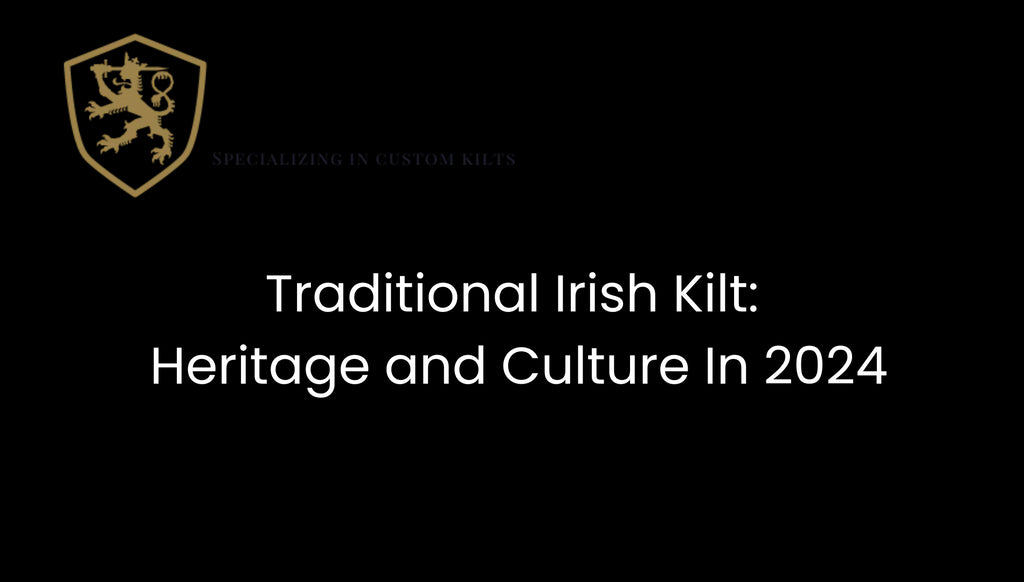Traditional Irish Kilt: Heritage and Culture In 2024
Posted by FAGENT ABRONT

The traditional Irish kilt ,often overshadowed by its Scottish counterpart, holds a significant place in the tapestry of Celtic heritage and culture. This article aims to demystify the origins, significance, and enduring legacy of the Irish kilt, offering insights into its design, customs, and contemporary relevance.
The Irish kilt boasts a storied history, intertwined with the cultural and historical fabric of Ireland. Despite common misconceptions, the Irish kilt has roots distinct from the Scottish kilt and plays a crucial role in Irish heritage. This article will explore the traditional Irish kilt's significance, design, and customs, shedding light on its importance as a symbol of pride and cultural identity.
The History and Origins of the Irish Kilt
Contrary to popular belief, the Irish kilt shares a Celtic connection with its Scottish cousin, yet it has evolved uniquely within Ireland's cultural context. The history of the Irish kilt stretches back to ancient times, with notable differences and similarities in its adoption and adaptation compared to the Scottish kilt. The 20th century witnessed a revival of interest in the Irish kilt, marking its resurgence as a symbol of national identity and cultural pride.
Design and Symbolism
The design of the traditional Irish kilt, particularly its tartan patterns and colors, carries deep symbolic meaning. The Saffron kilt, distinguished by its vibrant yellow hue, stands out as a significant variant, often associated with Irish nationalism and identity. Accompanying accessories such as the sporran, kilt pin, and ghillie brogues not only complete the ensemble but also serve as nods to the intricate customs surrounding the kilt's wear.
Irish Kilts in Cultural and Family Traditions
Irish kilts play a pivotal role in weddings, formal occasions, and cultural festivals, symbolizing clan and family heritage. Their presence in national celebrations like St. Patrick's Day and at Highland games highlights the kilt's role in promoting Irish culture and uniting communities around shared traditions.
Contemporary Use and Fashion
In modern fashion, the Irish kilt has adapted to contemporary tastes while retaining its traditional essence. This fusion of old and new underscores the kilt's versatility and its significance in promoting Irish culture on a global stage. The comparison between traditional and contemporary materials and styles illustrates the kilt's evolution while maintaining its cultural significance.
Choosing and Wearing an Irish Kilt
Selecting the right Irish kilt involves considering tartan patterns, material, and length, ensuring the attire is appropriate for the occasion. This section provides guidelines for choosing, wearing, and maintaining an Irish kilt, ensuring that this cultural garment is both a statement of heritage and a testament to personal style.
Irish Kilt Makers and Retailers
Authentic Irish kilts can be sourced from renowned kilt makers in Ireland and abroad, offering both custom and off-the-shelf options. This section offers tips for purchasing an authentic Irish kilt, highlighting the importance of craftsmanship and quality in choosing this emblematic garment.
The traditional Irish kilt stands as a proud emblem of heritage and culture, encapsulating the spirit and history of Ireland. Its enduring legacy and contemporary relevance invite individuals to explore and embrace the kilt not just as a garment but as a symbol of pride and identity. As we delve into the rich tapestry of the Irish kilt, we are reminded of the timeless connection it fosters among those who wear it, bridging past and present in a celebration of Irish culture.
This comprehensive exploration aims to enlighten readers about the traditional Irish kilt's historical roots, cultural significance, and modern adaptations, encouraging a deeper appreciation for this storied garment.
